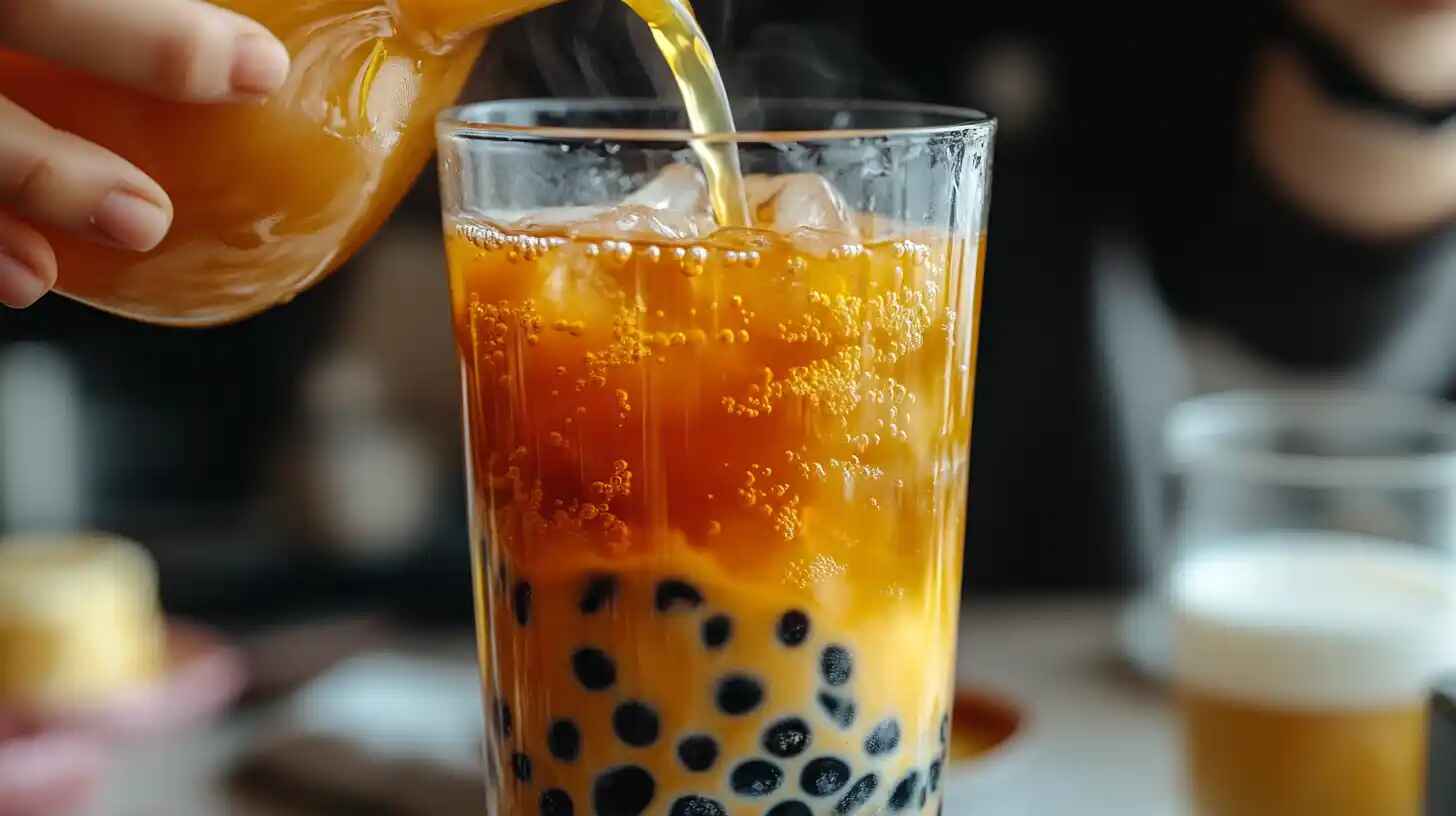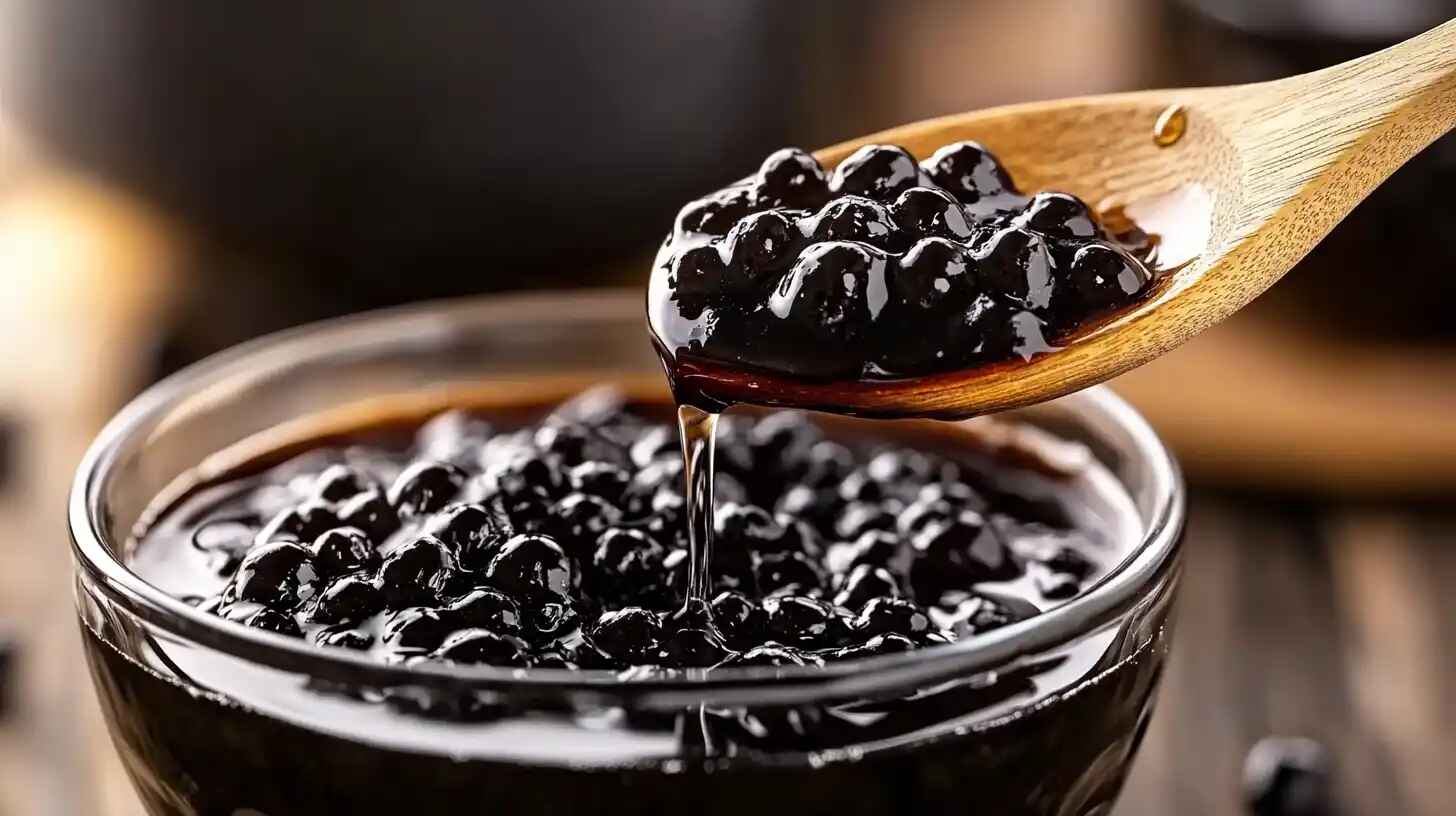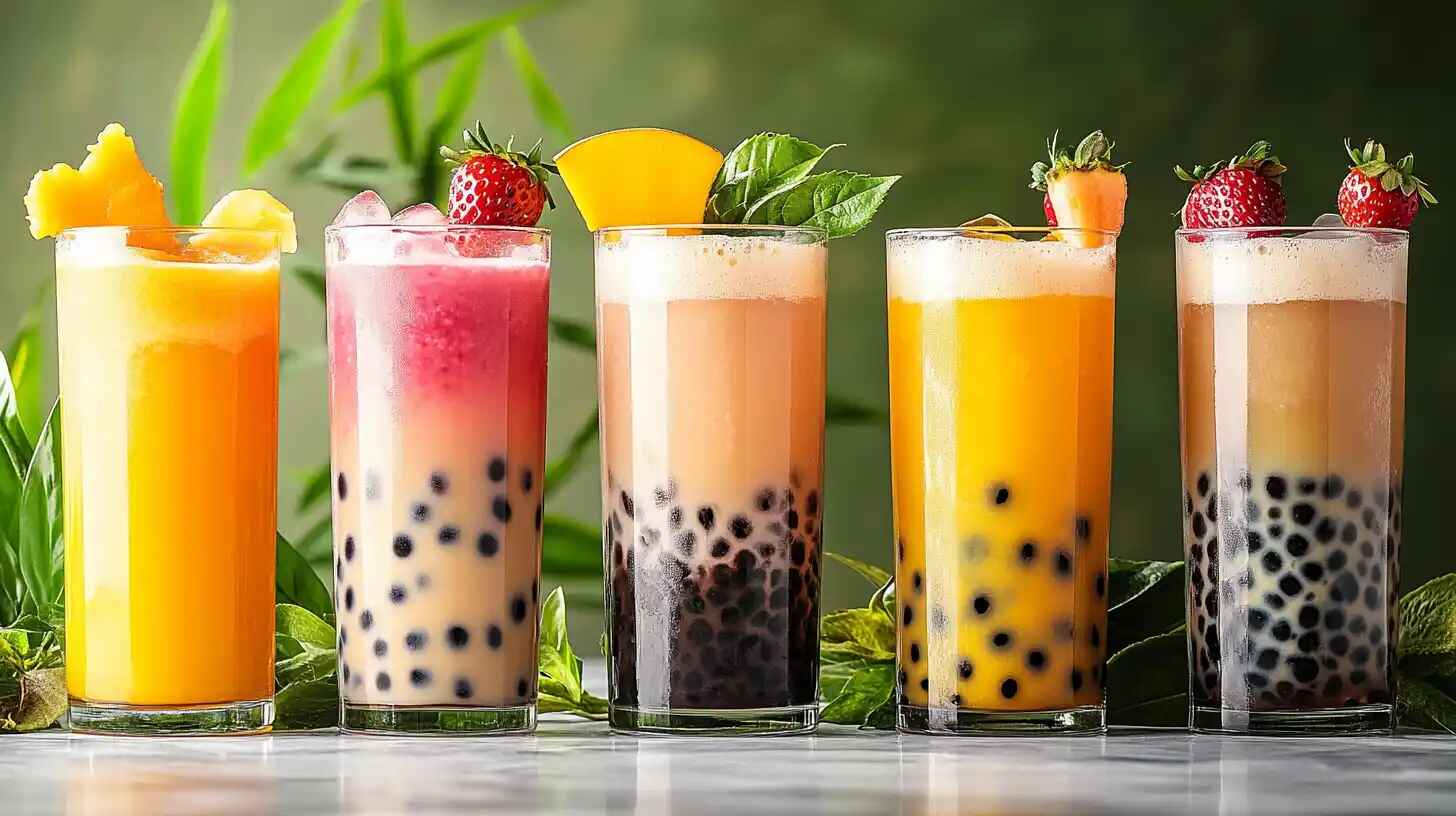Boba tea, also known as bubble tea, has taken the world by storm. From the bustling streets of Taiwan to trendy cafes in New York and London, this delicious, chewy drink has become a global sensation. But what exactly makes boba tea so special? Where did it come from? And how can you make it at home? In this ultimate guide, we’ll answer all your boba-related questions and even help you fix common problems along the way!
Table of Contents

What is Boba Tea? A Complete Overview
Boba tea is a sweet, flavorful drink that typically consists of three main components: tea, milk (or non-dairy alternatives), and chewy tapioca pearls. It can be served hot or cold, and there are endless variations depending on the flavors and toppings you choose. Some people prefer fruit-based boba tea, while others stick to the creamy, traditional milk tea.
Understanding the Origins of Boba Tea
Boba tea originated in Taiwan in the 1980s. It is believed that the first version of this drink was created by a tea shop owner who decided to mix tapioca balls with sweet milk tea. The idea quickly spread, and soon, boba tea became a staple in Taiwanese culture.
Boba tea’s popularity exploded in the 1990s and 2000s, thanks to its fun texture and customizable flavors. Today, you can find boba shops in nearly every major city worldwide.
Why is Boba Tea So Popular?
The appeal of boba tea lies in its unique combination of flavors and textures. The chewy tapioca pearls add an interactive element to drinking tea, making it not just a beverage but an experience. Plus, with social media showcasing aesthetic boba drinks, it’s no surprise that people love snapping and sharing their boba moments!
The Key Ingredients That Make Boba Tea Unique
Let’s break down the essential components of boba tea:
Tea Base: The Foundation of Boba Tea
The tea base determines the overall flavor of your drink. The most common tea bases include:
- Black tea: Classic and bold, often used in traditional milk tea.
- Green tea: Lighter and refreshing, pairs well with fruit flavors.
- Oolong tea: A balanced mix between black and green tea.
- Herbal teas: Caffeine-free options like hibiscus or chamomile.
Tapioca Pearls: The Iconic Chewy Delight
These little black pearls are made from tapioca starch, giving them their signature chewiness. However, they need to be cooked properly to achieve the right texture.
Sweeteners and Flavor Enhancers
Depending on your preference, you can sweeten your boba tea with:
- Sugar (white, brown, or cane sugar)
- Honey
- Simple syrup
- Condensed milk
Milk and Non-Dairy Alternatives
If you’re a fan of creamy drinks, milk is a must-have in boba tea. But if you’re lactose intolerant, don’t worry! There are plenty of dairy-free alternatives like almond milk, oat milk, and coconut milk.
Popular Boba Tea Flavors and Variations
One of the best things about boba tea is that there’s a flavor for everyone. Whether you prefer classic milk tea or adventurous fruity blends, there’s no shortage of options.
Classic Flavors: Milk Tea, Taro, and Thai Tea
These are some of the most beloved traditional flavors:
- Milk Tea: A simple yet delicious combination of black tea, milk, and sweetener.
- Taro Milk Tea: A purple-hued drink with a nutty, vanilla-like flavor.
- Thai Tea: Made with Thai spices, sweetened condensed milk, and black tea.
Fruity Boba Tea: Mango, Strawberry, and Passionfruit
If you’re looking for something refreshing, fruit-based boba teas are a great choice. Popular options include:
- Mango Boba Tea
- Strawberry Boba Tea
- Passionfruit Green Tea
Unique and Exotic Boba Flavors Around the World
Some boba shops offer creative and exotic flavors, such as:
- Matcha Boba Tea
- Coffee Boba
- Lavender Milk Tea
- Cheese Foam Boba

How to Make Boba Tea at Home: Step-by-Step Guide
Making boba tea at home is easier than you think! Here’s a simple guide to get you started.
Ingredients and Equipment Needed
| Ingredient | Quantity |
|---|---|
| Black tea (or any tea of choice) | 2 tea bags or 1 tbsp loose leaf |
| Water | 2 cups |
| Tapioca pearls | ½ cup |
| Milk or non-dairy alternative | ½ cup |
| Sweetener (sugar, honey, etc.) | 2 tbsp |
| Ice cubes | 1 cup |
Cooking Tapioca Pearls Perfectly
- Bring a pot of water to a rolling boil.
- Add tapioca pearls and stir to prevent sticking.
- Let them cook for about 15 minutes until soft.
- Drain and soak in sugar syrup for extra flavor.
Brewing the Perfect Tea Base
- Boil water and steep your tea for 3-5 minutes.
- Remove tea bags or strain loose leaves.
- Add sweetener while the tea is still hot.
Mixing and Assembling Your Boba Tea
- Fill a glass with cooked tapioca pearls.
- Add ice cubes and pour in your brewed tea.
- Stir in milk or a dairy-free alternative.
- Insert a wide straw and enjoy!
Homemade boba tea lets you control sweetness, flavor, and ingredients—plus, it’s way more affordable than buying from a store!
Health Benefits and Concerns of Boba Tea
Boba tea is undeniably delicious, but is it good for you? Like any treat, it has its pros and cons. Let’s take a closer look at its nutritional value, health benefits, and potential drawbacks.
Nutritional Value of Boba Tea
The nutritional content of boba tea varies depending on the ingredients used. Here’s a general breakdown of a typical 16 oz (475 ml) serving of classic milk tea with tapioca pearls:
| Nutrient | Amount |
|---|---|
| Calories | 250-400 kcal |
| Carbohydrates | 50-70g |
| Sugar | 30-50g |
| Fat | 5-10g |
| Protein | 2-5g |
Is Boba Tea Healthy? Myths vs. Facts
Let’s clear up some common misconceptions:
- Myth: Boba tea is always unhealthy.
Fact: It depends on how it’s made! Opting for less sugar and healthier toppings can make it a better choice. - Myth: Tapioca pearls are bad for digestion.
Fact: They are made from cassava root and are safe in moderation. However, eating too many may cause bloating. - Myth: Boba tea is loaded with artificial ingredients.
Fact: While some boba shops use artificial flavors, you can make it at home with natural ingredients.
How to Make Boba Tea Healthier
If you love boba but want a healthier version, try these simple tweaks:
- Reduce sugar: Ask for 50% or 25% sugar at boba shops.
- Swap sweeteners: Use honey, stevia, or agave syrup instead of refined sugar.
- Choose non-dairy milk: Almond, oat, or coconut milk can be healthier options.
- Limit tapioca pearls: Consider using less or switching to alternatives like chia seeds.
Common Problems When Making or Ordering Boba Tea (and How to Fix Them)
Ever ordered or made boba tea and ended up disappointed? Here are some common issues and how to fix them.
Tapioca Pearls Too Hard or Too Mushy?
If your boba pearls don’t have the right chewiness, here’s why:
- Too hard: They weren’t cooked long enough. Try boiling them for 15-20 minutes and letting them sit in hot water for another 10 minutes.
- Too mushy: They were overcooked. Reduce cooking time slightly and avoid leaving them in water for too long.
Tea Too Bitter or Too Weak?
Getting the tea base right is crucial:
- Too bitter: The tea steeped for too long. Stick to 3-5 minutes.
- Too weak: You might need more tea leaves or a stronger variety.
How to Reduce Sugar Without Losing Flavor
Many people love boba tea but worry about sugar intake. Here’s how you can cut sugar without sacrificing taste:
- Use natural sweeteners like honey or dates.
- Reduce sugar in the tea base but keep a little in the tapioca pearls.
- Add fresh fruit for natural sweetness.
The Rise of Boba Tea Shops: A Global Trend
Boba tea isn’t just a drink—it’s a phenomenon! Over the years, it has grown from a Taiwanese specialty to a worldwide craze.
Famous Boba Tea Brands and Franchises
Some of the biggest names in the boba industry include:
- Chatime: Known for its wide variety of flavors and global presence.
- Kung Fu Tea: A favorite in the U.S. for its strong, authentic tea taste.
- The Alley: Famous for its signature brown sugar milk tea.
- CoCo Fresh Tea & Juice: Offers a balance of classic and modern flavors.
The Expansion of Boba Tea in Western Countries
In the past decade, boba tea has taken off in North America, Europe, and even the Middle East. What makes it so appealing?
- The drink is customizable, catering to different tastes.
- Social media has made boba tea trendy and shareable.
- More people are looking for unique, Instagram-worthy beverages.
DIY Boba Tea: Creative Recipes to Try at Home
Feeling adventurous? Here are some fun, creative boba tea recipes you can make at home.
Vegan and Dairy-Free Boba Tea Recipes
Try this simple coconut milk tea:
- Brew a strong black tea.
- Mix with coconut milk and sweeten with maple syrup.
- Add ice and tapioca pearls.
Alcoholic Boba Tea: A Fun Twist
Boba tea isn’t just for kids! Try adding a splash of your favorite spirit:
- Rum + Thai tea = Tropical Boba
- Whiskey + brown sugar boba = Bourbon Bliss
- Vodka + fruit tea = Berry Boba Martini
Dessert Boba: Ice Cream, Pudding, and More
Upgrade your boba by adding unique toppings like:
- Vanilla ice cream for a creamy treat.
- Pudding for an extra smooth texture.
- A drizzle of caramel or chocolate syrup.
Boba Tea and Social Media: The Instagram-Worthy Drink
Boba tea isn’t just tasty—it’s also visually stunning. Social media platforms like Instagram and TikTok have played a huge role in making boba tea popular worldwide.
Why Boba Tea is a Viral Sensation
Why do people love posting pictures of boba tea? It’s simple:
- Bright, colorful drinks look amazing in photos.
- Unique toppings and layers create eye-catching visuals.
- People love sharing their custom boba orders.
TikTok and Instagram Trends in Boba Tea
Some of the biggest trends include:
- Brown sugar boba: A rich, caramel-like drink.
- DIY boba kits: Making boba tea at home.
- Galaxy boba: Multi-colored drinks that look like outer space.
Aesthetic Boba Shops and Their Influence
Many boba shops are designed with Instagram in mind—pastel walls, neon signs, and trendy decor all contribute to the experience.

Frequently Asked Questions (FAQs) About Boba Tea
What is the difference between boba tea and bubble tea?
There’s no difference! Boba tea and bubble tea are just two names for the same drink. Other common names include pearl milk tea and tapioca tea.
Is boba tea healthy?
Boba tea can be high in sugar and calories, but you can make it healthier by reducing sugar, using non-dairy milk, or opting for alternative toppings like chia seeds.
What does boba tea taste like?
The taste depends on the tea base and added ingredients. Classic milk tea is creamy and slightly sweet, while fruity boba teas are refreshing and vibrant.
How do I cook tapioca pearls properly?
Boil them in water for 15-20 minutes until they turn soft and chewy, then let them sit for another 10 minutes. Soak them in sugar syrup for extra flavor.
Can I make boba tea without tapioca pearls?
Yes! You can use alternatives like fruit jelly, popping boba, or grass jelly to get a similar chewy texture without using tapioca pearls.
What type of tea is best for making boba?
Black tea is the most common base, but green tea, oolong, or herbal teas also work well. Choose your tea based on the flavor profile you prefer.
How long do cooked tapioca pearls last?
Cooked pearls are best consumed within 4-6 hours. If stored longer, they may become too hard or mushy. Always keep them in sugar syrup to maintain their texture.
Can I store homemade boba tea for later?
It’s best to drink boba tea fresh. If you must store it, keep the tea and pearls separate in the fridge and combine them when ready to drink.
Pair Your Boba Tea with a Decadent Chocolate Mousse Pie
If you’re looking for the perfect dessert to enjoy alongside your boba tea, a rich and creamy Chocolate Mousse Pie is a fantastic choice! The silky, melt-in-your-mouth texture of the chocolate mousse perfectly complements the chewy tapioca pearls in your drink, creating a delightful contrast of flavors and textures. Whether you’re sipping on a classic milk tea or a fruity boba variation, the deep, velvety chocolate pairs beautifully with the sweetness of your beverage. Try it with a brown sugar boba for an extra indulgent treat, or pair it with matcha boba tea for a balanced mix of bitter and sweet flavors. One sip, one bite, and you’re in dessert heaven!
Last Bite
From its humble beginnings in Taiwan to its global success, boba tea continues to evolve. With new flavors, healthier options, and creative recipes emerging every day, it’s safe to say that this chewy, delightful drink is here to stay!
if you want to learn more about the world “Boba” check this out.

